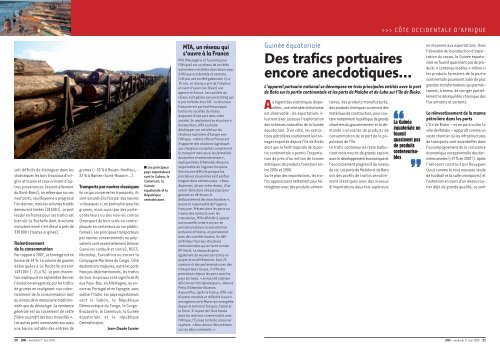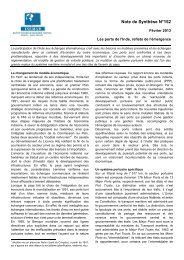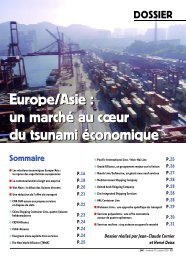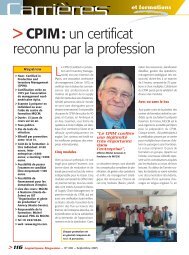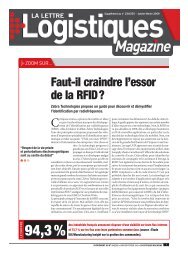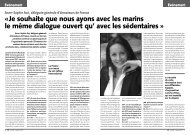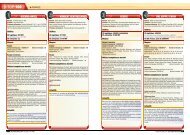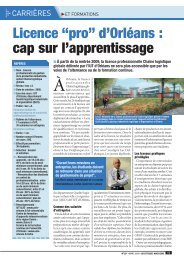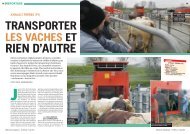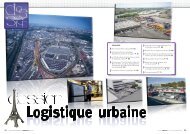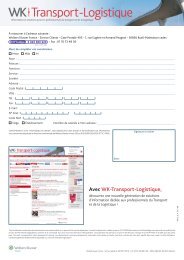Téléchargez le dossier du Journal de la Marchande - WK Transport ...
Téléchargez le dossier du Journal de la Marchande - WK Transport ...
Téléchargez le dossier du Journal de la Marchande - WK Transport ...
- No tags were found...
Create successful ePaper yourself
Turn your PDF publications into a flip-book with our unique Google optimized e-Paper software.
CÔTE OCCIDENTALE D’AFRIQUEmesures sur <strong>le</strong>s exportations <strong>de</strong> sucre,l’Europe n’a plus approvisionné<strong>le</strong> marché africain. Ce <strong>de</strong>rnier s’estalors rapproché <strong>de</strong> l’Amérique <strong>du</strong> Sud.« Si l’Europe reste toujours présenteen Afrique, <strong>la</strong> caractéristique récente<strong>de</strong> cette économie est son ouverturesur <strong>la</strong> mondialisation », indique A<strong>la</strong>inCazor<strong>la</strong>.Des perspectives qui n’altèrent en rien<strong>la</strong> confiance <strong>du</strong> responsab<strong>le</strong> <strong>de</strong> l’armement.«Je reste confiant. Nous allonsconnaître une pério<strong>de</strong> diffici<strong>le</strong>mais l’Afrique <strong>de</strong>meure un continentd’approvisionnement avant tout. Ence<strong>la</strong>, c’est une chance qui lui permettrad’éviter <strong>de</strong>s effets trop dévastateurs.» De plus, <strong>la</strong> crise se répercutepour une <strong>la</strong>rge part sur <strong>le</strong>s traficsconteneurisés. En ce<strong>la</strong> l’Afrique n’estpas épargnée. Les événements récentsà l’image <strong>de</strong>s décisions <strong>de</strong> DPWorld au Sénégal, à Dakar en attestent.Après <strong>de</strong>s débuts diffici<strong>le</strong>s, l’opérateura réussi à se redresser. AuGhana, <strong>le</strong> port ne dispose pas <strong>de</strong>moyens suffisants pour répondre à <strong>la</strong><strong>de</strong>man<strong>de</strong>. Au Nigeria, l’infrastructurene permet pas <strong>de</strong> répondre aux attentesd’une popu<strong>la</strong>tion en croissancedémographique. « Avec 140 millionsd’habitants, ce pays a besoin <strong>de</strong> portsefficaces pour faire face aux besoinslocaux », note A<strong>la</strong>in Cazor<strong>la</strong>.MSC investit à San PedroFace à ce manque <strong>le</strong>s armements commencentà investir loca<strong>le</strong>ment pourpouvoir disposer <strong>de</strong> <strong>le</strong>urs propresmoyens <strong>de</strong> manutention. Un conceptdémarré par <strong>le</strong> groupe Delmas, lorsqu’ilétait encore dans <strong>le</strong> giron <strong>du</strong> groupeBolloré. La manutention en Afriqueest restée dans <strong>le</strong>s mains <strong>de</strong> VincentBolloré alors que l’armement a étécédé au groupe CMA CGM. Aujourd’huil’Afrique <strong>de</strong>s ports est <strong>de</strong>venue unmarché à investir. Après <strong>le</strong> groupe <strong>de</strong>Vincent Bolloré, ce fut Progosa puisDP World et <strong>de</strong>s armements commeMaersk Line et Zim à prendre p<strong>la</strong>ce.Le nouvel arrivant dans <strong>la</strong> manutentionrégiona<strong>le</strong> est l’armement <strong>de</strong>Genève, MSC. Il a décidé d’opérer <strong>le</strong>spremiers investissements sur <strong>le</strong> port <strong>de</strong>San Pedro, en Côte d’Ivoire. La stratégie<strong>de</strong> l’armement vise à s’imp<strong>la</strong>nterloca<strong>le</strong>ment en coopération avecune société loca<strong>le</strong>, en l’occurrenceGetma. « Nous mettons <strong>de</strong>s moyensen propre sur <strong>la</strong> région. Nous l’avonsdéjà fait sur Lomé et Las Palmas, nous<strong>le</strong> déclinons aujourd’hui sur SanPedro. » Des mesures qui doivent permettre<strong>de</strong> résorber <strong>la</strong> congestion chroniquedont souffrent <strong>le</strong>s ports africains<strong>de</strong>puis plusieurs années. Unealternative? La véritab<strong>le</strong> réponse vientsurtout <strong>de</strong> <strong>la</strong> mise en p<strong>la</strong>ce <strong>de</strong>s moyensnouveaux mis en p<strong>la</strong>ce dans <strong>le</strong>s portspar <strong>le</strong>s opérateurs, selon <strong>le</strong> responsab<strong>le</strong><strong>de</strong> MSC.Après avoir investi dans <strong>de</strong> nouvel<strong>le</strong>slignes dédiées et dans <strong>le</strong>s ports, MSCse tourne maintenant vers <strong>de</strong>s services<strong>de</strong> fee<strong>de</strong>ring dédiés. Une façon<strong>de</strong> répondre à <strong>la</strong> <strong>de</strong>man<strong>de</strong> <strong>de</strong>s popu<strong>la</strong>tionsafricaines en <strong>de</strong>sservant l’ensemb<strong>le</strong><strong>de</strong>s ports <strong>de</strong> <strong>la</strong> région. Le système<strong>de</strong> MSC repose sur <strong>de</strong>s servicesdirects entre l’Europe et l’Afrique <strong>de</strong>l’Ouest mais aussi sur <strong>de</strong>s p<strong>la</strong>tes-formeslogistiques comme Las Palmasou Va<strong>le</strong>nce en Espagne. « Ces <strong>de</strong>uxports nous permettent <strong>de</strong> créer <strong>de</strong>sconnexions avec <strong>le</strong> mon<strong>de</strong> entier sur <strong>la</strong>région. Les services <strong>de</strong> fee<strong>de</strong>ring viendrontcompléter ce dispositif.»Desservir l’Afrique signifie aussi <strong>de</strong>disposer <strong>de</strong> moyens terrestres pouraccé<strong>de</strong>r aux marchés enc<strong>la</strong>vés. Unpoint essentiel qui occupe une <strong>la</strong>rgepart <strong>de</strong>s débats lors <strong>de</strong>s réunions <strong>de</strong>l’AGPAOC (Assemblée généra<strong>le</strong> <strong>de</strong>sports d’Afrique occi<strong>de</strong>nta<strong>le</strong> et centra<strong>le</strong>).Lors <strong>de</strong> <strong>la</strong> <strong>de</strong>rnière réunion, enmai 2008, <strong>le</strong> sujet a <strong>la</strong>rgement étéabordé. Le directeur général <strong>du</strong> port<strong>de</strong> Cotonou, Jérôme Dandjinou, a expliquélors <strong>de</strong> cette assemblée que <strong>le</strong>développement économique passeavant tout par <strong>la</strong> fluidité <strong>de</strong>s échan-“Desservirl’Afriquesignifie aussi<strong>de</strong> disposer<strong>de</strong> moyensterrestrespour accé<strong>de</strong>raux marchésenc<strong>la</strong>vés”ges commerciaux. «La mise en p<strong>la</strong>ced’un système <strong>de</strong> transport efficaceest donc un impératif <strong>de</strong> développementqui nécessite <strong>de</strong>s ports maritimesperformants, <strong>de</strong>s routes en bonétat dépourvues <strong>de</strong> barrages, <strong>de</strong>s lignes<strong>de</strong> chemin <strong>de</strong> fer fonctionnel<strong>le</strong>set <strong>de</strong>s postes frontaliers ré<strong>du</strong>isant aumaximum <strong>le</strong>s formalités administrativeset douanières. En Afrique, l’efficacité<strong>du</strong> système <strong>de</strong> transport terrestrecombiné (rail/route) permettra<strong>de</strong> ré<strong>du</strong>ire <strong>le</strong>s coûts <strong>de</strong> transport <strong>de</strong>spro<strong>du</strong>its et <strong>de</strong> <strong>le</strong>s rendre compétitifssur <strong>le</strong> marché international », a rapporté<strong>le</strong> site Internet Trafic mag après<strong>la</strong> réunion <strong>de</strong> l’AGPAOC <strong>de</strong> mai 2008.Une position que partage A<strong>la</strong>in Cazor<strong>la</strong>.Évolutions positivessur <strong>le</strong> continentIl constate <strong>de</strong>s évolutions positivessur <strong>le</strong> continent. Des grands projetsprennent forme. Le chemin <strong>de</strong> fer <strong>de</strong>vientefficace, notamment en Côted’Ivoire, selon <strong>le</strong> responsab<strong>le</strong> <strong>de</strong> MSC.Des lignes existent au Sénégal avecplus ou moins d’efficacité et <strong>de</strong>s investissementsétrangers sont prévus.Ce défi à re<strong>le</strong>ver sur <strong>le</strong>s transportsterrestres en Afrique <strong>de</strong> l’Ouest doitpermettre une meil<strong>le</strong>ure intégrationéconomique <strong>de</strong>s pays enc<strong>la</strong>vés. Desenjeux importants pour l’Afrique mêmes’ils ne sont pas <strong>le</strong>s principaux fournisseurs<strong>de</strong> marchés. « L’évolutionrécente montre que ces pays changent<strong>le</strong>urs dispositifs logistiques.L’exemp<strong>le</strong> <strong>le</strong> plus marquant est <strong>le</strong> Mali.Il passait avant par <strong>le</strong> port d’Abidjan.Aujourd’hui <strong>le</strong>s exportateurs et importateursmaliens diversifient <strong>le</strong>ursroutes vers <strong>le</strong>s ports. » Pour répondreà cette nouvel<strong>le</strong> donne <strong>le</strong>s armementsdoivent disposer d’une <strong>de</strong>sserteintérieure efficace. Après avoirmisé sur <strong>le</strong>s services dédiés et <strong>le</strong>sports, <strong>la</strong> prochaine conquête africainepourrait bien se faire par <strong>le</strong> routieret <strong>le</strong> ferroviaire.Hervé DeissBois tropicauxTendance à <strong>la</strong> baisseL’époque où <strong>le</strong>s ports voyaient passer <strong>de</strong> grosses cargaisons unitaires<strong>de</strong> grumes exotiques est, semb<strong>le</strong>-t-il, révolue. En 2008, <strong>le</strong>trafic <strong>de</strong> bois tropicaux dans <strong>le</strong>s ports français s’affiche à <strong>la</strong> baisse,même si <strong>la</strong> conjoncture actuel<strong>le</strong> ajoute un peu à une tendance plusgloba<strong>le</strong>.Il y a encore quelques années, <strong>de</strong>sarmements – français notamment– alignaient <strong>de</strong>s flottes <strong>de</strong> naviresgrumiers spécialisés. Aujourd’hui<strong>la</strong> flotte française ne compte plus véritab<strong>le</strong>mentque quatre navires orientéstransport <strong>de</strong> bois (mais qui peuventcharger bien d’autres pro<strong>du</strong>its),<strong>le</strong>s unités <strong>de</strong> <strong>la</strong> série A<strong>de</strong>line-Delmas,<strong>de</strong>s conbulkers <strong>de</strong> 33 000 TPL.Cette tendance <strong>de</strong> fond à <strong>la</strong> baisse<strong>de</strong>s volumes trouve son origine d’unepart dans une volonté <strong>de</strong>s États <strong>de</strong>développer <strong>la</strong> transformation sur p<strong>la</strong>ce– ce qui con<strong>du</strong>it à <strong>de</strong>s exportations<strong>de</strong> bois sciés ou <strong>de</strong> contrep<strong>la</strong>qués à<strong>la</strong> p<strong>la</strong>ce <strong>de</strong>s grumes brutes –, d’autrepart à <strong>la</strong> concurrence <strong>de</strong>s <strong>de</strong>stinations(forte <strong>de</strong>man<strong>de</strong> chinoise ouasiatique en général).Les grumes <strong>de</strong> feuillustropicaux en retraitD’après <strong>le</strong>s services <strong>du</strong> ministère <strong>de</strong>l’Agriculture et <strong>de</strong> <strong>la</strong> Pêche, <strong>le</strong>s importations<strong>de</strong> grumes <strong>de</strong> feuillus tropicaux(toutes origines) se sontcontractées pour <strong>le</strong>s neuf premiersmois <strong>de</strong> 2008 (avec - 6 % en va<strong>le</strong>ur).«Les importations <strong>de</strong> bois ronds tro-“La contraction<strong>de</strong>s trafics <strong>de</strong>bois estgénéra<strong>le</strong> dans<strong>le</strong>s portsfrançais”picaux, après une tendance à <strong>la</strong> ré<strong>du</strong>ctionjusqu’en 2006, avaient repris<strong>le</strong>ur progression en 2007 mais se stabilisenten 2008 avec un montant <strong>de</strong>163 M¤ sur <strong>le</strong>s douze <strong>de</strong>rniers mois.»En ce qui concerne <strong>le</strong>s sciages, <strong>le</strong> ministèreindique : «Après <strong>la</strong> reprise <strong>de</strong>2007, <strong>le</strong> recul <strong>de</strong>s importations s’accélère<strong>de</strong>puis <strong>le</strong> <strong>de</strong>puis <strong>le</strong> début <strong>de</strong>l’année 2008, <strong>de</strong> sorte qu’el<strong>le</strong>s diminuent<strong>de</strong> 8 % sur <strong>le</strong>s douze <strong>de</strong>rniersmois. Sur cette pério<strong>de</strong>, <strong>le</strong>s volumesimportés proviennent pour 43 %d’Afrique occi<strong>de</strong>nta<strong>le</strong>, 45 % <strong>du</strong> Brési<strong>le</strong>t 12 % d’Asie <strong>du</strong> Sud-Est.»Au niveau <strong>de</strong>s ports français, <strong>la</strong>contraction <strong>de</strong>s trafics <strong>de</strong> bois tropicauxest assez généra<strong>le</strong>.Actuel<strong>le</strong>ment, neuf d’entre eux sontconcernés régulièrement par ce type<strong>de</strong> frets, <strong>de</strong>ux en Méditerranée (Sèteet Marseil<strong>le</strong>-Fos) et sept en faça<strong>de</strong>At<strong>la</strong>ntique, Manche, mer <strong>du</strong> Nord(Bayonne, Bor<strong>de</strong>aux, La Rochel<strong>le</strong>,Nantes-Saint-Nazaire, Caen, Rouen-Honf<strong>le</strong>ur et Dunkerque). Bien qu’il18 JMM - vendredi 1 er mai 2009JMM - vendredi 1 er mai 2009 19


